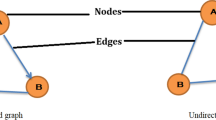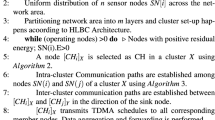Abstract
The area of wireless sensor networks (WSNs) has gained significant attention from researchers due to its expansive range of applications, such as industrial regulation, human detection, and medical diagnosis. WSN is a vast number of geographically scattered devices that use sensor nodes to communicate and gather information from the target region. In clustered WSNs, the cluster head (CH) is deliberated as the relay node at a higher energy level than the non-CH nodes. The relay nodes perform more tasks related to the non-CHs, and these relay nodes are restricted by energy and communication capacity. Therefore, balancing the load of the relay node is a significant concern for improving the performance of the WSNs. Clustering is a well-known technique enforced to balance the load of the relay nodes. Often, densely loaded relay nodes dissolve their energy in less time and may cause changes in the topology of the network. In this study, we propose a Quasi-oppositional based Jaya load balancing strategy (QOJ-LBS) with a novel fitness function to address the issue of load balancing. The novel fitness function derived from the convex combination of the least lifespan of the relay node across the network and the entropy value of the lifespan of all relay nodes. The proposed QOJ-LBS justifies the network performance under two different WSN conditions called scenario-1 and scenario-2 with single-hop and multi-hop routing. The experimental analysis shows that improvement in network lifespan, total energy utilization, and the number of active sensor nodes of WSN is statistically significant in proposed QOJ-LBS compared to other state-of-the-art algorithms.













Similar content being viewed by others
References
Akyildiz, I. F., Su, W., Sankarasubramaniam, Y., & Cayirci, E. (2002). Wireless sensor networks: A survey. Computer Networks, 38(4), 393–422.
Yick, J., Mukherjee, B., & Ghosal, D. (2008). Wireless sensor networks survey. Computer Networks, 52(12), 2292–2330.
Dietrich, I., & Dressler, F. (2009). On the lifetime of wireless sensor networks. ACM Transactions on Sensor Networks (TOSN), 5(1), 1–39.
Yetgin, H., Cheung, K. T. K., El-Hajjar, M., & Hanzo, L. (2014). Cross-layer network lifetime maximization in interference-limited WSNs. IEEE Transactions on Vehicular Technology, 64(8), 3795–3803.
Liu, W., Lu, K., Wang, J., Xing, G., & Huang, L. (2012). Performance analysis of wireless sensor networks with mobile sinks. IEEE Transactions on Vehicular Technology, 61(6), 2777–2788.
Halil, Y., Cheung, K. T. K., El-Hajjar, M., & Hanzo, L. (2015). Network-lifetime maximization of wireless sensor networks. IEEE Access, 3, 2191–2226.
Yetgin, H., Cheung, K. T. K., El-Hajjar, M., & Hanzo, L. H. (2017). A survey of network lifetime maximization techniques in wireless sensor networks. IEEE Communications Surveys & Tutorials, 19(2), 828–854.
Boyinbode, O., Le, H., Mbogho, A., Takizawa, M., Poliah, R. (2010). A survey on clustering algorithms for wireless sensor networks. In 13th international conference on network-based information systems (pp. 358–364).
Bandyopadhyay, S., & Coyle, E. J. (2003). An energy efficient hierarchical clustering algorithm for wireless sensor networks. In IEEE twenty-second annual joint conference of the IEEE computer and communications societies (INFOCOM) (Vol. 3, pp. 1713–1723).
Low, C. P., Fang, C., Ng, J. M., & Ang, Y. H. (2008). Efficient load-balanced clustering algorithms for wireless sensor networks. Computer Communications, 31(4), 750–759.
Kuila, P., & Jana, P. K. (2011). Improved load balanced clustering algorithm for wireless sensor networks. In International conference on advanced computing, networking and security (pp. 399–404).
Kuila, P., & Jana, P. K. (2014). A novel differential evolution based clustering algorithm for wireless sensor networks. Applied Soft Computing, 25, 414–425.
Liu, X., & Zhang, P. (2017). Data drainage: A novel load balancing strategy for wireless sensor networks. IEEE Communications Letters, 22(1), 125–128.
Liao, W.-H., Kao, Y., & Fan, C.-M. (2008). Data aggregation in wireless sensor networks using ant colony algorithm. Journal of Network and Computer Applications, 31(4), 387–401.
Lai, C.-C., Ting, C.-K., & Ko, R.-S. (2007). An effective genetic algorithm to improve wireless sensor network lifetime for large-scale surveillance applications. In IEEE Congress on evolutionary computation (pp. 3531–3538).
Ari, A. A. A., Yenke, B. O., Labraoui, N., Damakoa, I., & Gueroui, A. (2016). A power efficient cluster-based routing algorithm for wireless sensor networks: Honeybees swarm intelligence based approach. Journal of Network and Computer Applications, 69, 77–97.
Jiang, C., Yuan, D., & Zhao, Y. (2009). Towards clustering algorithms in wireless sensor networks-a survey. In IEEE wireless communications and networking conference (pp. 1–6).
Heinzelman, W. R., Chandrakasan, A., & Balakrishnan, H. (2000). Energy-efficient communication protocol for wireless microsensor networks. In IEEE proceedings of the 33rd annual Hawaii international conference on system sciences (pp. 1–10).
Lindsey, S., & Raghavendra, C. S. (2002). PEGASIS: Power-efficient gathering in sensor information systems. In Proceedings, IEEE aerospace conference (Vol. 3, p. 3).
Younis, O., & Fahmy, S. (2004). HEED: A hybrid, energy-efficient, distributed clustering approach for ad hoc sensor networks. IEEE Transactions on Mobile Computing, 3(4), 366–379.
Kumar, N., & Kaur, J. (2011). Improved leach protocol for Wireless Sensor networks. In IEEE 7th international conference on wireless communications, networking and mobile computing (pp. 1–5).
Xiangning, F., & Yulin, S. (2007). Improvement on LEACH protocol of wireless sensor network. In IEEE international conference on sensor technologies and applications (pp. 260–264).
Kumar, D., Aseri, T. C., & Patel, R. B. (2009). EEHC: Energy efficient heterogeneous clustered scheme for wireless sensor networks. Computer Communications, 32(4), 662–667.
Kuila, P., & Jana, P. K. (2012). Energy efficient load-balanced clustering algorithm for wireless sensor networks. Procedia Technology, 6, 771–777.
Polepally, V., & Chatrapati, K. S. (2019). Dragonfly optimization and constraint measure-based load balancing in cloud computing. Cluster Computing, 22, 1099–1111.
Huang, X., Li, C., Chen, H., & An, D. (2020). Task scheduling in cloud computing using particle swarm optimization with time varying inertia weight strategies. Cluster Computing, 23, 1137–1147.
Bari, A., Wazed, S., Jaekel, A., & Bandyopadhyay, S. (2009). A genetic algorithm based approach for energy efficient routing in two-tiered sensor networks. Ad Hoc Networks, 7(4), 665–676.
Kuila, P., Gupta, S. K., & Jana, P. K. (2013). A novel evolutionary approach for load balanced clustering problem for wireless sensor networks. Swarm and Evolutionary Computation, 12, 48–56.
Kuila, P., & Jana, P. K. (2014). Energy efficient clustering and routing algorithms for wireless sensor networks: Particle swarm optimization approach. Engineering Applications of Artificial Intelligence, 33, 127–140.
Elhoseny, M., Yuan, X., Yu, Z., Mao, C., El-Minir, H. K., & Riad, A. M. (2015). Balancing energy consumption in heterogeneous wireless sensor networks using genetic algorithm. IEEE Communications Letters, 19(12), 2194–2197.
Zhou, Y., Wang, N., & Xiang, W. (2017). Clustering hierarchy protocol in wireless sensor networks using an improved PSO algorithm. IEEE Access, 5, 2241–2253.
Edla, D. R., Lipare, A., & Cheruku, R. (2018). Shuffled complex evolution approach for load balancing of gateways in wireless sensor networks. Wireless Personal Communications, 98(4), 3455–3476.
Edla, D. R., Lipare, A., Cheruku, R., & Kuppili, V. (2017). An efficient load balancing of gateways using improved shuffled frog leaping algorithm and novel fitness function for WSNs. IEEE Sensors Journal, 17(20), 6724–6733.
Heinzelman, W. B., Chandrakasan, A. P., & Balakrishnan, H. (2002). An application-specific protocol architecture for wireless microsensor networks. IEEE Transactions on Wireless Communications, 1(4), 660–670.
Rao, R. (2016). Jaya: A simple and new optimization algorithm for solving constrained and unconstrained optimization problems. International Journal of Industrial Engineering Computations, 7(1), 19–34.
Rao, R. V. (2019). Jaya optimization algorithm and its variants. In R. V. Rao (Ed.), Jaya: An advanced optimization algorithm and its engineering applications (pp. 9–58). Berlin: Springer.
Bari, A., Jaekel, A., & Bandyopadhyay, S. (2008). Clustering strategies for improving the lifetime of two-tiered sensor networks. Computer Communications, 31(14), 3451–3459.
Author information
Authors and Affiliations
Corresponding author
Additional information
Publisher's Note
Springer Nature remains neutral with regard to jurisdictional claims in published maps and institutional affiliations.
Rights and permissions
About this article
Cite this article
Kongara, M.C., Kuppili, V. & Edla, D.R. Energy-Efficient Load Balancing Strategy for Wireless Sensor Networks using Quasi-oppositional based Jaya Optimization. Wireless Pers Commun 118, 2319–2343 (2021). https://doi.org/10.1007/s11277-021-08128-5
Accepted:
Published:
Issue Date:
DOI: https://doi.org/10.1007/s11277-021-08128-5





